James M. Bardeen
Last updatedJames M. Bardeen | |
|---|---|
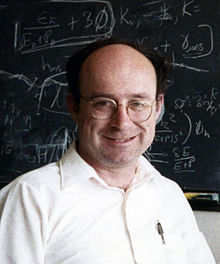 Bardeen in 1980 | |
| Born | James Maxwell Bardeen May 9, 1939 Minneapolis, Minnesota, U.S. |
| Died | June 20, 2022 (aged 83) Seattle, Washington, U.S. |
| Education | Harvard University (BS) California Institute of Technology (PhD) |
| Known for | Laws of black hole thermodynamics |
| Scientific career | |
| Fields | Physics |
| Institutions | University of Washington Perimeter Institute |
| Doctoral advisor | Richard P. Feynman William A. Fowler |
James Maxwell Bardeen (May 9, 1939 – June 20, 2022) was an American physicist, well known for his work in general relativity, particularly his role in formulating the laws of black hole mechanics. He also discovered the Bardeen vacuum, an exact solution of the Einstein field equation.
Contents
Early life and education
Bardeen was born in Minneapolis, Minnesota, on May 9, 1939. [1] His father, John Bardeen, won the Nobel Prize in Physics twice for inventing the transistor and formulating the theory of superconductivity; [1] [2] his mother, Jane Maxwell Bardeen, worked as a zoologist and a high school teacher. During his childhood, Bardeen resided in Washington, D.C., Summit, New Jersey, and Chicago as part of his father's employment. He attended the University Laboratory High School in Urbana, Illinois. He then studied physics at Harvard University, even though his father wanted him to go into biology. [1] After graduating in 1960, he undertook graduate studies at the California Institute of Technology under the direction of Richard Feynman and William Alfred Fowler. [1] [3] Bardeen was awarded a Doctor of Philosophy in 1965. [1]
Career
Bardeen first worked at Caltech and the University of California, Berkeley, in postdoctoral positions. He became a part of the astronomy department of the University of Washington in 1967. He subsequently joined Yale University in 1972. That same year, he co-authored the watershed paper "The Four Laws of Black Hole Mechanics" with Stephen Hawking and Brandon Carter during a meeting held at the École de physique des Houches. Later that year, Bardeen theorized the doughnut-shape and size of a black hole’s "shadow", which was later popularized by the observations of Messier 87 by the Event Horizon Telescope. [1]
Bardeen returned to the University of Washington in 1976, remaining there until his retirement in 2006. Together with Michael S. Turner and Paul Steinhardt, he published a paper in 1982 detailing the way submicroscopic fluctuations in the density of matter and energy in the early universe would bring about the arrangement of galaxies seen in the present day. [1] Bardeen was also a Distinguished Visiting Research Fellow [4] at Perimeter Institute for Theoretical Physics. In 2012, he was elected to the U.S. National Academy of Sciences. [5]
Personal life
Bardeen married Nancy Thomas in 1968. They met the year before in Paris while he was attending a conference, and remained married until his death. Together, they had two children, William and David. [1]
Bardeen's brother, William A. Bardeen, was also a physicist. [1] His sister, Elizabeth, was married to Thomas Greytak, a physicist at MIT. In a 2020 interview given to Federal University of Pará in Brazil, Bardeen recalls his journey as a physicist, his father's influences on him, his experiences as a doctoral student of Richard Feynman, and working with Stephen Hawking. [6] [7] [8]
Bardeen died on June 20, 2022, at a retirement home in Seattle. He was 83, and suffered from cancer prior to his death. [1]
See also
Related Research Articles
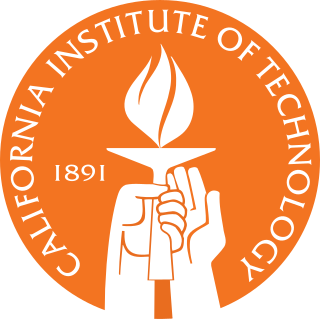
The California Institute of Technology (branded as Caltech) is a private research university in Pasadena, California. The university is responsible for many modern scientific advancements and is among a small group of institutes of technology in the United States which are strongly devoted to the instruction of pure and applied sciences. Due to its history of technological innovation, Caltech has been considered to be one of the world's most prestigious universities.

Murray Gell-Mann was an American physicist who played a preeminent role in the development of the theory of elementary particles. Gell-Mann introduced the concept of quarks as the fundamental building blocks of the strongly interacting particles, and the renormalization group as a foundational element of quantum field theory and statistical mechanics. He played key roles in developing the concept of chirality in the theory of the weak interactions and spontaneous chiral symmetry breaking in the strong interactions, which controls the physics of the light mesons. In the 1970s he was a co-inventor of quantum chromodynamics (QCD) which explains the confinement of quarks in mesons and baryons and forms a large part of the Standard Model of elementary particles and forces.

Paul Adrien Maurice Dirac was an English mathematical and theoretical physicist who is considered to be one of the founders of quantum mechanics and quantum electrodynamics. He is credited with laying the foundations of quantum field theory. He was the Lucasian Professor of Mathematics at the University of Cambridge, a professor of physics at Florida State University and the University of Miami, and a 1933 Nobel Prize in Physics recipient.
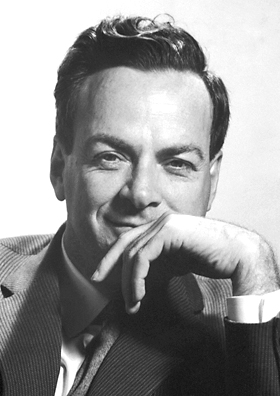
Richard Phillips Feynman was an American theoretical physicist, known for his work in the path integral formulation of quantum mechanics, the theory of quantum electrodynamics, the physics of the superfluidity of supercooled liquid helium, as well as his work in particle physics for which he proposed the parton model. For his contributions to the development of quantum electrodynamics, Feynman received the Nobel Prize in Physics in 1965 jointly with Julian Schwinger and Shin'ichirō Tomonaga.
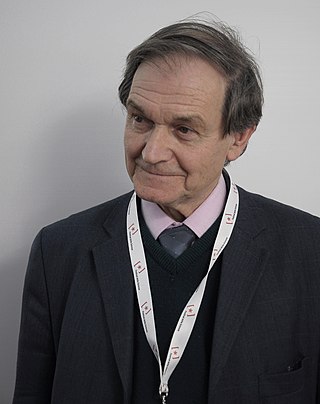
Sir Roger Penrose is an English mathematician, mathematical physicist, philosopher of science and Nobel Laureate in Physics. He is Emeritus Rouse Ball Professor of Mathematics in the University of Oxford, an emeritus fellow of Wadham College, Oxford, and an honorary fellow of St John's College, Cambridge, and University College London.
Timeline of black hole physics
The no-hair theorem states that all stationary black hole solutions of the Einstein–Maxwell equations of gravitation and electromagnetism in general relativity can be completely characterized by only three independent externally observable classical parameters: mass, electric charge, and angular momentum. Other characteristics are uniquely determined by these three parameters, and all other information about the matter that formed a black hole or is falling into it "disappears" behind the black-hole event horizon and is therefore permanently inaccessible to external observers after the black hole "settles down". Physicist John Archibald Wheeler expressed this idea with the phrase "black holes have no hair", which was the origin of the name.
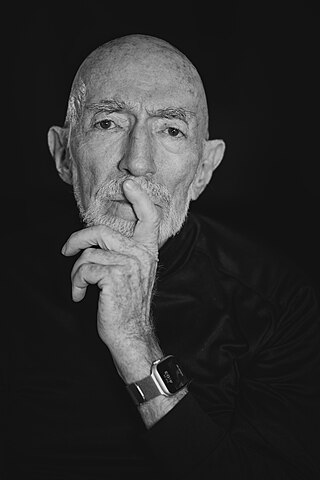
Kip Stephen Thorne is an American theoretical physicist known for his contributions in gravitational physics and astrophysics. Along with Rainer Weiss and Barry C. Barish, he was awarded the 2017 Nobel Prize in Physics for his contributions to the LIGO detector and the observation of gravitational waves.

Leonard Susskind is an American theoretical physicist, Professor of theoretical physics in Stanford University and founding director of the Stanford Institute for Theoretical Physics. His research interests are string theory, quantum field theory, quantum statistical mechanics and quantum cosmology. He is a member of the US National Academy of Sciences, and the American Academy of Arts and Sciences, an associate member of the faculty of Canada's Perimeter Institute for Theoretical Physics, and a distinguished professor of the Korea Institute for Advanced Study.
Werner Israel, OC FRSC FRS was a distinguished theoretical physicist best known for his contributions to gravitational theory, and especially to the understanding of black holes.

Amal Kumar Raychaudhuri was an Indian physicist, known for his research in general relativity and cosmology. His most significant contribution is the eponymous Raychaudhuri equation, which demonstrates that singularities arise inevitably in general relativity and is a key ingredient in the proofs of the Penrose–Hawking singularity theorems. Raychaudhuri was also revered as a teacher during his tenure at Presidency College, Kolkata.
This timeline lists significant discoveries in physics and the laws of nature, including experimental discoveries, theoretical proposals that were confirmed experimentally, and theories that have significantly influenced current thinking in modern physics. Such discoveries are often a multi-step, multi-person process. Multiple discovery sometimes occurs when multiple research groups discover the same phenomenon at about the same time, and scientific priority is often disputed. The listings below include some of the most significant people and ideas by date of publication or experiment.

Robert M. Wald is an American theoretical physicist and professor at the University of Chicago. He studies general relativity, black holes, and quantum gravity and has written textbooks on these subjects.

Reinhard Genzel is a German astrophysicist, co-director of the Max Planck Institute for Extraterrestrial Physics, a professor at LMU and an emeritus professor at the University of California, Berkeley. He was awarded the 2020 Nobel Prize in Physics "for the discovery of a supermassive compact object at the centre of our galaxy", which he shared with Andrea Ghez and Roger Penrose. In a 2021 interview given to Federal University of Pará in Brazil, Genzel recalls his journey as a physicist; the influence of his father, Ludwig Genzel; his experiences working with Charles H. Townes; and more.
"On Physical Lines of Force" is a four-part paper written by James Clerk Maxwell, published in 1861. In it, Maxwell derived the equations of electromagnetism in conjunction with a "sea" of "molecular vortices" which he used to model Faraday's lines of force. Maxwell had studied and commented on the field of electricity and magnetism as early as 1855/56 when "On Faraday's Lines of Force" was read to the Cambridge Philosophical Society. Maxwell made an analogy between the density of this medium and the magnetic permeability, as well as an analogy between the transverse elasticity and the dielectric constant, and using the results of a prior experiment by Wilhelm Eduard Weber and Rudolf Kohlrausch performed in 1856, he established a connection between the speed of light and the speed of propagation of waves in this medium.

The Feynman Lectures on Physics is a physics textbook based on a great number of lectures by Richard Feynman, a Nobel laureate who has sometimes been called "The Great Explainer". The lectures were presented before undergraduate students at the California Institute of Technology (Caltech), during 1961–1963. The book's co-authors are Feynman, Robert B. Leighton, and Matthew Sands.
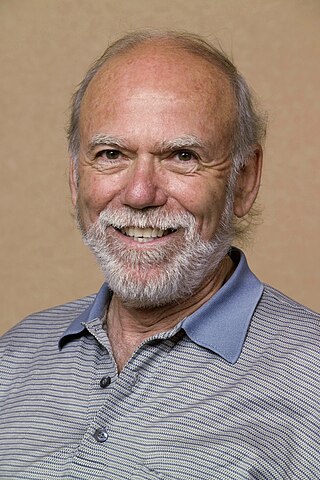
Barry Clark Barish is an American experimental physicist and Nobel Laureate. He is a Linde Professor of Physics, emeritus at California Institute of Technology and a leading expert on gravitational waves.
John R. Tucker was an American physicist who made several contributions to the fields of electronics, physics and microwave theory, known for generalizing the microwave mixer theory and presenting the body of work, known as the "Tucker theory", and for his fundamental theoretical contributions which resulted into various advancements in experimental Submillimeter astronomy. He is also credited with laying down some of the technological foundations for making practical Quantum computing possible.
The Princeton University Department of Physics is an academic department dedicated to research and teaching at Princeton University. The associated faculty members, researchers, and students have been recognized for their research contributions, having been awarded 19 Nobel Prizes, four National Medals of Science, and two Wolf Prizes in Physics. Notable professors, researchers, and graduate students affiliated with the department include Richard Phillips Feynman, Joseph H. Taylor, Jim Peebles, Eugene P. Wigner, and John von Neumann. In addition, the department offers degree programs for bachelor's students (A.B.) and doctoral students (Ph.D.).
References
- 1 2 3 4 5 6 7 8 9 10 Overbye, Dennis (July 3, 2022). "James Bardeen, an Expert on Unraveling Einstein's Equations, Dies at 83". The New York Times . Retrieved July 3, 2022.
- ↑ Hoddeson, Lillian; Daitch, Vicki (2002). True genius: the life and science of John Bardeen : the only winner of two Nobel Prizes in physics. Joseph Henry Press. p. 93. ISBN 978-0-309-08408-6.
- ↑ Bardeen, James Maxwell – CaltechTHESIS